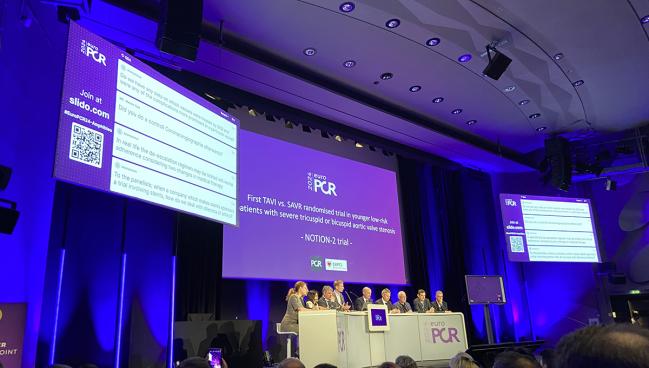Young, Low-risk Patients Fare Well With TAVI, but Beware the Bicuspids
The NOTION-2 investigators say their trial lines up with other low-risk trials, but results extend only to those with tricuspid AS.

PARIS, France—Another study in patients with severe aortic stenosis deemed low risk for surgery confirms the similar clinical outcomes, at least short term, for TAVI when compared with surgical aortic valve replacement.
The study, known as NOTION-2, did raise a red flag when it came to treating low-risk patients with bicuspid aortic anatomy, with investigators highlighting worse clinical outcomes in this group, including a higher risk of stroke, over 1-year follow-up.
At the present time, operators should be quite selective when it comes to treating bicuspid aortic stenosis with TAVI, said De Backer, noting there is still a lot to learn about which phenotypes do well with the percutaneous approach. If the decision is made to proceed with TAVI, given the rates of stroke seen in NOTION-2, “we maybe should also consider the use of cerebral embolic protection,” said De Backer.
Martin Leon, MD (NewYork-Presbyterian/Columbia University Irving Medical Center, New York, NY), one of the panelists during the late-breaking clinical trials session, said that smaller studies and registry data published to date have shown that operators were very choosy when treating patients with bicuspid aortic valve morphology with TAVI.
“It’s clear that if you’re going to treat bicuspids, you have to be very careful about how we phenotype these patients to be certain that we’re not exposing them to undue risk,” he said. “It also points to the issue that if we are going to get into bicuspids, we’re going to need far more definitive randomized trials with a larger number of patients.”
Another panelist, Sabine Bleiziffer, MD (Heart and Diabetes Center NRW, Bad Oeynhausen, Germany), was more direct.
“I want to be very clear and very brief,” she said. “In my eyes, and also after seeing these data, TAVI in bicuspid aortic stenosis is only for nonsurgical patients. We have a lot of data generated already about this topic and there is a lot more to learn, [but] I think these data just confirm what is already in the clinical guidelines—we should tend to do surgery in bicuspid aortic stenosis.”
To TCTMD, Jörg Hausleiter, MD (Ludwig Maximillian University, Munich, Germany), who wasn’t involved in the study, said that when managing patients with bicuspid aortic stenosis, any treatment decision should be made on an individual basis depending on the patient’s surgical risk.
“We treat bicuspid patients, but as it’s showing [in NOTION-2], we probably don't know yet the best strategy,” he said. “We need to study these patients much more because we can’t take the data which we have for tricuspid aortic stenosis patients and just apply it to bicuspid patients. It’s not as easy, and this clearly shows we need to have a dedicated study evaluating which bicuspid patients we could potentially treat with TAVI and who might be better sent for surgery.”
Davide Capodanno, MD, PhD (University of Catania, Italy), who presented an analysis adjudicating the trial design, pointed out that NOTION-2 investigators powered the trial based on the PARTNER 3 results, only to have their primary endpoint event rate in the surgical arm come in much lower than the assumed 15.0%. While there are nuances to interpreting noninferiority studies, Capodanno said the NOTION-2 trial investigators can’t claim noninferiority because the upper confidence bound surpassed the assumed noninferiority margin of 5% (HR 1.4; 95% CI 0.2-8.5).
At the end of the day, NOTION-2 is inconclusive, said Capodanno.
As such, the subgroup analysis based on valve morphology should only be used for “descriptive purposes” or “hypothesis-generating,” he added.
Excluding Bicuspid Patients in RCTs
There have been several clinical trials comparing TAVI against SAVR in patients at low risk for surgery. In addition to the PARTNER 3 and Evolut Low-Risk trials, the NOTION-1 and DEDICATE-DZHK6 trials compared the two procedures in a low-risk patient population, and midterm data have shown that TAVI and SAVR generally result in similar clinical outcomes, at least out to 4 or 5 years.
There are key differences between those studies and NOTION-2, however. In PARTNER 3 and the Evolut Low-Risk Trial, the mean age was 73 and 74 years, as compared with 79 and 74 years in NOTION-1 and DEDICATE-DZHK6. Importantly, all past trials excluded patients with bicuspid anatomy.
The NOTION-2 trial included low-risk patients ages 60 to 75 years with severe symptomatic aortic stenosis, who were randomized to TAVI or surgery. The mean age of the 370 randomized patients was 71 years. The mean STS PROM score was 1.1% and approximately one-quarter of those treated had a bicuspid valve detected on CT. The vast majority of these had a type 1 bicuspid aortic valve.
At 12 months, the primary endpoint of death, stroke, or rehospitalization occurred in 10.2% of patients treated with TAVI and 7.1% of those treated with surgery (P = 0.3). The risk of death or disabling stroke was also not statistically different between the two study arms (3.2% with TAVI vs 1.6% with surgery; P = 0.3). Stroke was significantly higher with TAVI, however, occurring in 5.4% of patients compared with 1.6% of those treated surgically (P = 0.05), a difference driven by a higher risk of nondisabling stroke.
In my eyes, and also after seeing these data, TAVI in bicuspid aortic stenosis is only for nonsurgical patients. Sabine Bleiziffer
With respect to other endpoints, De Backer said there were some wins for TAVI and some wins for surgery. Risks of major or life-threatening bleeding and atrial fibrillation were higher, and length of stay was longer, with surgery, while the need for a new permanent pacemaker and risk of moderate-or-greater paravalvular regurgitation were greater for TAVI.
In subanalyses looking specifically at valve morphology, the primary endpoint, and the harder endpoint of death and disabling stroke, no statistically significant differences were seen between TAVI and surgery in patients with tricuspid valves. However, there were trends toward poorer outcomes in TAVI-treated patients with bicuspid anatomy, with a near fourfold higher risk of death, stroke, or rehospitalization compared with those treated surgically (14.3% vs 3.9%; P = 0.07) and a threefold higher risk of death or disabling stroke (6.1% vs 2.0%; P = 0.3).
“The bicuspid patients represented just 26% of the study population,” said De Backer. “So largely underpowered, but it still gives us a nice indication of [which way] these results go.”
He added that they tried to be as inclusive as possible when enrolling such patients.
“All patients had a CT beforehand for screening so we could disqualify them from enrollment, but we were pretty liberal,” he said. Patients weren’t necessarily excluded if there was excessive calcification, which tends to be seen in younger patients with bicuspid anatomy. It’s possible, but speculative, that this higher amount of calcification is partly responsible for the worse outcomes, said De Backer.
To TCTMD, Hausleiter said the study as a whole is yet another step in the right direction, showing that TAVI is a comparable option to surgery in low-risk patients, with the strength of NOTION-2 being the inclusion of those younger than 75 years. Lifetime management, said Hausleiter, is the key buzzword these days.
“Long-term follow-up is definitely needed,” he said. “The downside is that when we get the long-term outcomes data, so many additional things have already changed again.”
To TCTMD, De Backer said that clinical practice in Europe differs from that in the United States, where TAVI is offered more systematically to younger patients. “This is not the case in Europe,” he said. “These patients would typically go automatically to surgery because they were between 60 and 75 years of age.” With NOTION-2, some of these younger patients saw the trial as an opportunity to get the less invasive therapy, he added.
Michael O’Riordan is the Managing Editor for TCTMD. He completed his undergraduate degrees at Queen’s University in Kingston, ON, and…
Read Full BioSources
De Backer O, on behalf of the NOTION-2 investigators. First TAVI vs SAVR randomized trial in younger low-risk patients with severe tricuspid or bicuspid aortic valve disease. Presented at: EuroPCR 2024. May 15, 2024. Paris, France.
Disclosures
- De Backer reports institutional grant support from Abbott, Boston Scientific, and Medtronic.







Comments